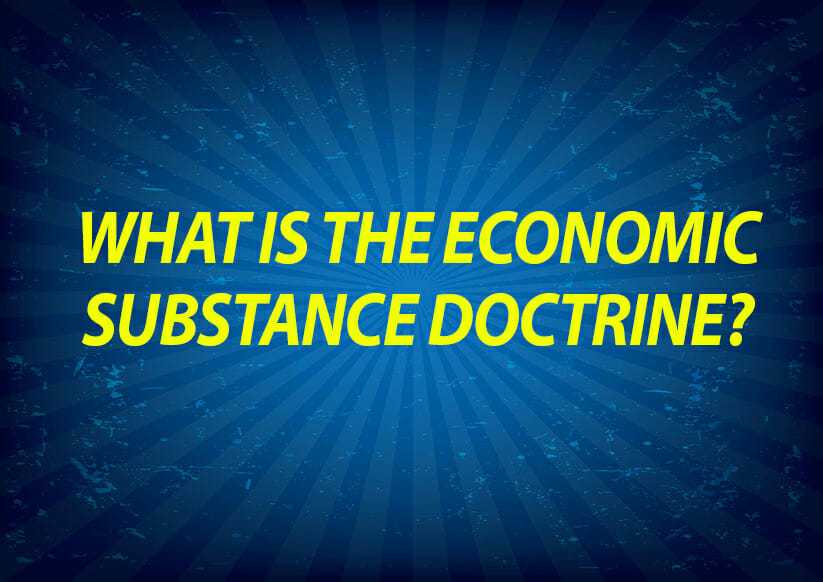
The economic substance doctrine or “sham in substance doctrine” arose out of common law, but has recently (as of 2010) been codified in IRC § 7701(o), which basically dictates that any transaction shall be treated as having economic substance only if both of the following two conditions are satisfied:
(i) Entering into the transaction changes the taxpayer’s economic position in a meaningful way apart from the income tax effects it may have; and
(ii) The taxpayer has a substantial business purpose for entering into such transaction (apart from its income tax effects).
The genesis of the “economic substance doctrine” is a common law doctrine that disallowed the tax benefits associated with a transaction if the transaction was deemed to lack economic substance or a business purpose.
a. Now that IRC §7701(a) codifies the economic substance doctrine, is the prior case law irrelevant?
The short answer is, “Not entirely.” The prior case law that addressed the economic substance doctrine continues to be relevant to determine whether the statute would apply to a set of facts. Specifically, Section 7701(o)(5)(C) states that this determination is to be made in the same manner as if section 7701(o) had never been enacted—in other words, the analysis is the same as it always was. Thus, the IRS will continue to look to case law for parallels to a taxpayer’s factual situation to see whether (i) the way he structured his affairs changed his economic position meaningfully, and whether (ii) he has substantial non-tax purpose for entering the transaction(s). If the parallel is strong enough, Section 7701(o)’s economic substance doctrine is triggered. For more, see the IRS’s website: https://www.irs.gov/irb/2010-40_IRB/ar09.html#d0e2391
However, prior case law is overruled to the extent it affirmed that a taxpayer need only satisfy one of the two prongs to avoid the application of the doctrine. The statute requires that taxpayers satisfy both; if case law disagrees with this, it is overridden. Consequently any prior case law which only required one prong of the test be satisfied has limited applicability for tax years subsequent to the enactment of §7701 in 2010.
b. Are there any “safe harbors” for the economic substance doctrine?
Unfortunately, no. However, in limited circumstance the IRS analyses the taxpayer’s profit motive in determining if the economic substance doctrine has been satisfied. But, in deciding whether Sections 7701(o)(1)(A) and (B) are met—i.e. whether a meaningful change in economic position and a substantial, non-tax business purpose exist—the IRS will consider the taxpayer’s profit motive to be sufficient to satisfy the economic substance doctrine where the present value of the reasonably expected pre-tax profit is substantially greater than the present value of the expected net tax benefits that would be allowed if the transaction were respected for income tax purposes. And how does the IRS quantify these benefits? The IRS will rely on all available relevant case law. Presently, the IRS has failed to issue guidance regarding what pretax profit (or percentage ratio) between the expected profits and expected benefits is sufficient to satisfy the profit potential test. Therefore, unfortunately, there is presently no “safe harbor” for the taxpayer to know for certain whether he may avoid the economic substance doctrine.
c. What sorts of tax shelters have been attacked with the economic substance doctrine prior to the enactment of Section 7701(o)?
Prior to Congress enacting Section 7701(o), the economic substance doctrine was applied by the courts to various tax shelters, including the following (which have come to have clever acronyms):
- BEDS: Basis-enhancing derivatives structures. This is essentially a series of transactions entered into for the purpose of increasing the basis of corporate stock in order to reduce any capital gain on the sale of that stock.
- CARDS: Custom Adjustable Rate Debt Structure transactions, which involves a loss from a cross-currency swap that is offset against the gain from the sale of an unrelated business.
- BLISS: Basis Leveraged Investment Swap Spread transactions, which involves a highly complex series of connected transactions. It involves the sale by a subsidiary entity of substantially all of its assets at a sizeable gain, which is followed by a series of purchases and sales of both long and short options in foreign currency (through a method called a “digital option spread”). The subsidiary then contributes these options to a wholly owned partnership. Simultaneously, the partnership purchases shares of unrelated corporate stock from the open stock market. As a result of the capital contribution of the digital option spread transactions, the subsidiary increases its outside basis in the partnership interest; and when the partnership held by the subsidiary liquidates the resulting stock distribution back up to the subsidiary and has basis it will generate a loss when the stock is sold, offsetting the gain from the prior sale of the subsidiary’s assets.
- DAD: This is a distressed asset/debt transaction where a foreign retailer in bankruptcy reorganization contributes distressed receivables related to its bankruptcy estate to an American LLC (which is specifically formed to collect the receivables) in exchange for a majority interest in the LLC. The foreign retailer subsequently redeems its interest in the LLC for cash and then the LLC contributes a portion of the receivables in exchange for majority interests in several other newly created LLCs. American investors then are sold membership interests in the LLCs through an additional layer of LLCs, which function as holding companies. The series of related LLCs claim a carryover basis in the receivables based on their face value at contribution and then write off the basis in those receivables as bad debt, generating losses to the American investors. The original top level LLC then claims losses on the subsequent sale of the layered membership interests in the holding companies.












